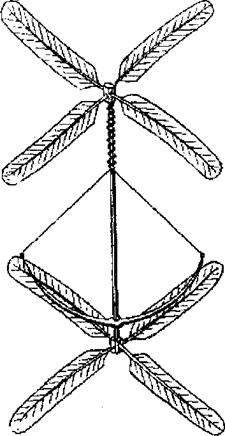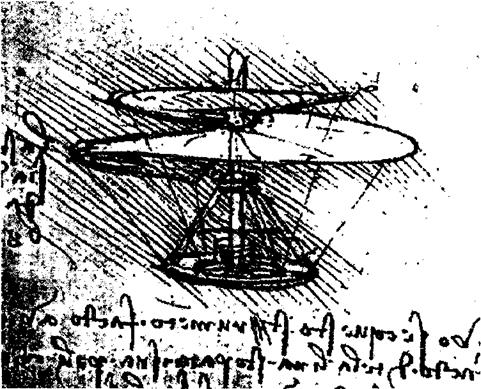Early Thinking
A timeline documenting the evolution of some key rotating-wing aircraft through 1950 is shown in Fig. 1.4, the year 1950 being the onset of large-scale commercial success for the helicopter. The ideas of vertical flight can be traced back to early Chinese tops, a toy first used about 400 BC. Everett-Heath (1986) and Liberatore (1998) give a detailed
 |
Figure 1.4 Timeline showing the development of helicopters and autogiros up to 1950.
history of such devices. The earliest versions of the Chinese top consisted of feathers at the end of a stick, which was rapidly spun between the hands to generate lift and then released into free flight. These toys were probably inspired by observations of the seeds of trees such as the maple and sycamore, whose whirling, autorotating seeds carry far on the breeze. While the Chinese top was no more than a toy, it is perhaps the first tangible device of what we may understand as a helicopter. The Chinese top is still a popular toy today.
|
Figure 1.5 A facsimile of the “Chinese Top” built by Launoy & Bienvenu in 1783. |
More than two millennia later, about 1754, Mikhail Lomonosov of Russia had developed a small coaxial rotor modeled after the Chinese top but powered by a wound-up spring device. In 1783, the French naturalist Launoy, with the assistance of a mechanic named Bienvenu, used a coaxial version of the Chinese top in a model consisting of a contrarotating set of turkey feathers. Their device was powered by a string wound around the rotor shaft that was tensioned by a crossbow (Fig. 1.5). When the tension was released, the rotor spun and the device climbed high into the air. Launoy & Bienvenu’s invention flew well and its success even created quite a stir in scientific circles. Inspired by the early success with these whirling tops, in 1786 the French mathematician A. J. R Paucton (1768) published a scientific paper titled “Theorie de la vis D’Archimede,” where he proposed one of the first concepts of a human-carrying helicopter.
Among his many hundreds of intricate drawings, the Renaissance visionary Leonardo da Vinci shows what is a basic human-carrying helicopter-like machine, which was an obvious elaboration of an Archemedes water-screw. His sketch of the “aerial-screw” or “air gyroscope” device (Fig. 1.6) is dated to 1483, but it was not published until the end of the eighteenth century. The device comprises a helical surface formed out of iron wire, with linen surfaces made “airtight with starch.” Da Vinci describes that the machine should be “rotated with speed that said screw bores through the air and climbs high ” He realized that the density of air was much less than that of water and so da Vinci describes how the device
|
Figure 1.6 Leonardo da Vinci’s aerial screw machine, dated to 1483. Original drawing is MS 2173 of Manuscript (codex) B, folio 83 verso, in the collection of the Biblotheque L’Institute de France (Paris). |
needed to be relatively large to produce enough lift to accomplish this feat – the number ‘8’ in his backward mirror image script and to the left of the sketch (Fig. 1.6) indicates that the size of the rotor is 8 braccia,[4] [5] which translates into a rotor of up to 26 ft (7.9 m) in diameter. Da Vinci clearly did not build his proposed machine except perhaps for some small models, but his idea was far ahead of its time. Although da Vinci worked on various concepts for engines, turbines, and gears, he did not seem to unite the ideas of his aerial-screw machine with an engine, nor did he seem to appreciate the concept of torque-reaction? Therefore, a torque applied to the rotor shaft will result in a reaction torque tending to rotate the platform from which the torque is applied. See Hart (1961) or Giacomelli (1930) for further details of da Vinci’s aeronautical inventions.
The great polymath, Sir George Cayley, is famous for his work on the basic principles of flight, which dates from the 1790s – see Pritchard (1961). As a young boy, Cayley had been fascinated by the Chinese top and by the end of the eighteenth century he had constructed several successful vertical-flight models with rotors made of sheets of tin and driven by wound-up clock springs. His fascination with flight led him to design and construct a whirling-arm device in 1804, which was probably one of the first scientific attempts to study the aerodynamic forces produced by lifting wings. Cayley (1809-1910) published
a three-part paper that was to lay down the scientific principles of aerodynamics – see Anderson (1997). In a later paper, published in 1843, Cayley gives details of a relatively large vertical flight aircraft design that he called an “Aerial Carriage.” The machine had two pairs of rotors, arranged side by side, to provide lift. However, the device remained an idea because the only powerplants available at the time were steam engines and these were much too heavy to allow for successful powered flight. Cayley’s convertiplane is, nevertheless, an interesting concept. The issue of torque reaction was solved by using contrarotating rotors and two propellers provided horizontal thrust to push the aircraft through the air. The design of the rotors was such that they flattened down to become solid disks and act as wings in forward flight, an idea possibly gleaned from the American Robert Taylor – see Liberatore (1998). Cayley suggested that an engine with considerable power would be needed to accomplish this feat and he even mentioned in his paper that “very great power, in proportion to the weight of the engine, is necessary.” While Cayley worked on engine concepts, it is not clear, however, if he ever actually attempted to establish the power requirements for vertical flight by means of theoretical calculations.
The lack of a suitable powerplant continued to stifle aeronautical progress, but the use of miniature, lightweight steam engines met with some success in powering smaller free-flying model helicopters. In the 1840s, another Englishman, W. H. Phillips, constructed a steam – driven vertical flight machine, where steam generated by boiling water in a miniature boiler was ejected out of the blade tips. Although impractical on a larger scale, Phillips’s machine was significant in that it marked the first time that a model helicopter had flown under the power of an engine rather than stored energy devices such as bowstrings or other types of wound-up springs. In the early 1860s, Ponton d’Amecourt of France attempted to fly a number of small steam-powered helicopter models. He called his machines helicopteres, which is a word derived from the Greek adjective elikoeioas, meaning spiral or winding, and the noun pteron, meaning feather or wing – see Wolf (1974) and Liberatore (1998). The novelist Jules Verne was impressed with d’Amecourt’s attempts at vertical flight and in 1886 he wrote “Robur le Conquerant” (later published in English as “The Clipper of the Clouds”) where the hero cruised around the skies in a giant helicopter-like machine that was lifted by thirty-seven small coaxial rotors and pulled through the air by two propellers. It was probably Jules Verne rather than d’Amecourt who is responsible for the word helicopter entering the standard lexicon.
Other notable vertical flight models that were constructed at about this time include Bright’s coaxial design in 1861 and Dieuaide’s twin-rotor steam-driven model in 1877. In 1865 Sir Charles Parsons of England built another type of helicopter model driven by a steam engine. Wilheim von Achenbach of Germany built a single rotor model in 1874, and he was probably the first to use the idea of a tail rotor to counteract the torque reaction from the main rotor. About 1869, a Russian helicopter concept was developed by Lodygin using a rotor for lift and a propeller for propulsion and control. Around 1878, Enrico Forlanini of Italy also built a flying steam-driven helicopter model. This model had dual contrarotating rotors, and it flew freely at heights of over 40 ft (12.2 m) for as much as twenty seconds.
In the 1880s, Thomas Alva Edison experimented with small helicopter models in the United States. He tested several rotor configurations driven by a guncotton engine, which was an early form of internal combustion engine. Later, Edison used an electric motor for power and he was one of the first to realize from his experiments the need for a large diameter rotor with low blade area to give good hovering efficiency [see Liberatore (1998)]. Edison was to say: “I got the motor and put it on the scales and tried a number of different things and contrivances [rotors] connected to the motor to see how it would lighten itself on the scale. I got some data and made up my mind that what was needed was a very powerful
engine for its weight.” Unlike other experimenters of the times, Edison’s more scientific approach to the problem proved that both high aerodynamic efficiency of the rotor and high power from an engine were required if successful vertical flight was ever to be achieved. In 1910, Edison patented a rather cumbersome looking full-scale helicopter concept with very nonaerodynamic looking boxkite blades, but there is no record that it was ever constructed – see Liberatore (1998) for further details.















